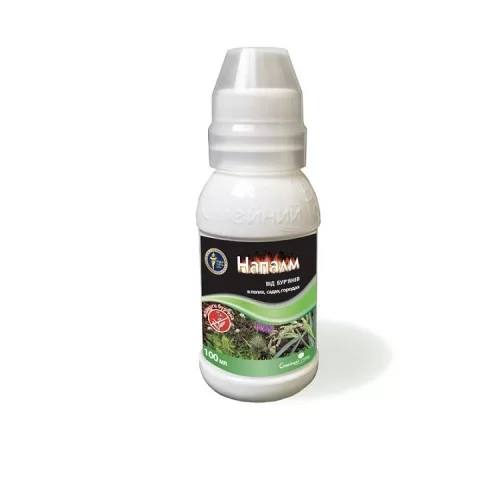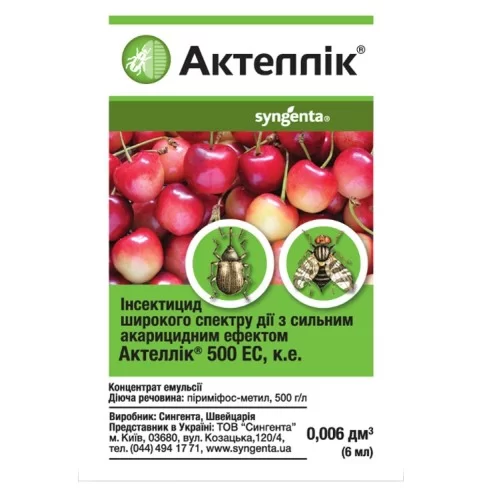Препарат Брунька 100 мл
Insecto-acaricide + fungicide
Active substances: phosphorous acid, 530 g/l + aluminum phosphite, 240 g/l + imidacloprid, 125 g/l + lambda-cyhalothrin, 10 g/l.
TU U 20.2-31052661-008:2012
The production technology was developed and implemented by the company "Cemiline Agro".
It has no analogues, a substitute for DNOK.
Preparation form: soluble concentrate.
Mechanism of action: The mechanism of action of the drug is multifunctional, aimed at effectively destroying harmful organisms.
Phosphorous acid (H3RO3), which gets on the plant when the drug is applied, and is also generated in the plant from aluminum phosphite by hydrolysis (double effect on the harmful object). Aluminum phosphite is an inorganic compound (salt of phosphorous acid). It is aluminum phosphite that has the optimal rate of hydrolysis, which results in the formation of phosphorous acid, and, therefore, the fungicidal properties of Bud are manifested in the best way.
The presence of imidacloprid makes it possible to effectively protect the plant from the overwintering stages of pests. Imidacloprid blocks the transmission of the insect's nerve impulse at the level of the postsynaptic membrane receptor. The vine has the ability to move quite freely through the plant, which allows it to protect untreated parts of the plant. Imidacloprid also has a pronounced anti-stress effect.
Lambda-cyhalothrin is a unique active ingredient with a contact mechanism of action. It quickly penetrates the pest throughout the cuticle, thereby stimulating the flow of nerve impulses through sodium channels in the pest's nervous tissues. This leads to excessive stimulation of the nervous system and rapid loss of control over muscle activity. It is lambda-cyhalothrin that has a higher activity and destroys a wide range of pests compared to other pyrethroids.
Due to the fact that phosphorous acid is able to quickly and deeply penetrate plant tissues, the introduction of imidacloprid and lambda-cyhalothrin into the plant cambium, in which the processes of vital activity and sap movement begin at a temperature of +5-8 atC. In this way, the active ingredients are distributed systematically throughout the plant cambium, which provides long-term protection against damage.
Direct effect on ovipositors and phytophagous insects that have emerged from overwintering.
Thus, a successful combination of active ingredients provides reliable protection for the plant. It has an acaricidal effect.
Purpose: Bud – a universal preparation for treating fruit and ornamental trees, vineyards and berry bushes before bud break against the overwintering stages of pathogens and pests.
Application and standards:
|
Culture |
Malicious object |
Consumption rates, ml/l |
Max. number of treatments |
Method, processing time, limitations |
|
Apple tree, pear tree
|
Overwintering stages of scale insects, scale insects, gray bud weevil, mites, aphids, mealybugs; leafhoppers, moths, leafflies (including pear honeydew), scab, moniliosis, other types of spotting |
20 |
2-4 |
Spraying trees before bud break |
|
Peach, apricot, plum, cherry, cherry |
Overwintering stages of scale insects, scale insects, mites, aphids, mealybugs, leafhoppers, moths, leaf lice; kleasterosporiosis, leaf curl, coccomycosis, moniliosis, other types of spotting |
20 |
2-4 |
Spraying trees before bud break |
| Vineyards | Overwintering stages of mites, mealybugs, anthracnose, mildew, oidium, spotted necrosis |
20 |
2-4 |
Spraying bushes before bud break |
Dosage and application: 20 мл/10 l water to moment bud break and 20ml/20l water after budding.
General recommendations: Spraying of plants is carried out 1-2 times a year, in the spring - before bud break, in the fall - after leaf fall. The working solution is prepared immediately before use.
Advantages:
- wide spectrum of insecto-acaricidal and fungicidal action;
- unlike DNOC, it has no herbicidal effect;
- long-lasting protective effect of the drug;
- can be used on homestead plots;
- ease of use.




